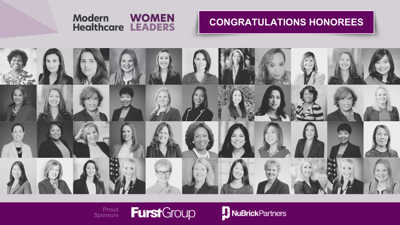She’s the chief medical information officer for one of the largest firms in the world, but AT&T’s Geeta Nayyar, M.D, MBA, wants you to know that it’s not about the technology.
One in a series of profiles of Modern Healthcare’s Top 25 Minority Executives in Healthcare (sponsored by Furst Group)
She’s the chief medical information officer for one of the largest firms in the world, but AT&T’s Geeta Nayyar, M.D, MBA, wants you to know that it’s not about the technology.
“It’s about people, and finding out how to make their lives better.”
At 33, she’s one of the youngest honorees of Modern Healthcare’s Top 25 Minority Executives in Healthcare awards program, but she’s been at this medicine thing a long time – she got into medical school at age 17.
“Both of my parents are physicians,” she explained. “I always was, and still am, a geeky science person, really fascinated by biology. But at the same time, I was always a very social person. So, clinical medicine just made sense because it was a joining of the best of both worlds.”
Her current role doesn’t call for it, but Nayyar made sure her employer would allow her to keep that aspect as an active part of her life.
“AT&T has been very supportive, and I am still on faculty at George Washington University in the department of rheumatology,” she says. “I still see patients. It’s only part-time, but I really enjoy it. And as much as healthcare keeps changing, it really is a valuable asset in my role.”
Nayyar says she sees technology as just another tool for physicians, like a stethoscope. She says her students at George Washington agree.
“The doctors that I teach now, in medical school and residency, can’t live without their tablets and smartphones – so why would they practice without them?” she says. “It is becoming so much more intuitive to use them. So if it helps you practice better medicine, why wouldn’t you?”
Beyond physicians, Nayyar believes patients are forcing the issue for the healthcare industry as well. “Patients say, ‘I can make a dinner reservation on my smartphone, but I can’t make my doctor’s appointment online. Why is that?’ ”
Although healthcare has lagged behind in adopting technology, Nayyar says the industry can use this to its advantage, by learning from the experiences of other businesses. The aviation industry, for example, has inspired strides in patient safety. Nayyar points to the banking industry as a more mundane model for how technology can transform patient care.
“The majority of people use online banking,” she says. “There are apps now where you can cash your checks; you don’t even have to go to the ATM. People are able to see in real time what their financial health is – how much has gone in, how much has gone out. We don’t have that right now for diabetes or hypertension or heart disease.”
Then there’s the bedrock necessity of clear doctor-patient communication.
“Often, patients leave the doctor’s office and forget 50 percent of what they were told, especially if there are prescriptions involved. There can be language and cultural barriers too,” Nayyar says. “In rheumatology, we give a lot of medications once a week or every other week. Patients sometimes misunderstand you and take them every day. Something really simple like that can have all kinds of astronomical side effects for patients. Technology can give patients a reference at home for these kinds of things that are hard to explain in a 10-minute visit.”
Nayyar says she sees her role at AT&T as part consultant (advising what products would appeal to what parts of the industry), part physician and patient advocate, and part ambassador (being the public face of AT&T healthcare and talking with stakeholders and policymakers about healthcare technology). She says she came to the company because she saw an opportunity to make a difference for more patients than she could ever see strictly as a clinician.
Like many in the industry, she and AT&T see the cloud as a definite part of the solution. “The problem is that our systems don’t talk to each other and there are barriers, including geographical ones, to getting access to records,” Nayyar says. “One of the beauties of the cloud is that, just like email, you can get it from anywhere, at any time, on any mobile device. In healthcare, that seamless transition hasn’t happened yet.”
The cloud, she notes, could help ACOs “lay out that clinical integration road map. If an organization is looking to become an ACO and integrate between their hospital and their outpatient center and with their patients who might be at home, the cloud can be a great integrator.”
While healthcare is facing seismic change, she said she thinks the business world could learn a few things from medicine as well.
“I think one of the most beautiful things we have in medicine is something called ‘M&M’ – morbidity and mortality rounds,” she says. “It’s where we reflect on a case where it just went wrong. We dissect where something went wrong, or we did our best but the patient didn’t make it, or there was this horrible, adverse effect. We try to understand what went wrong and we think about what we can do to make it go better. But what I have noticed in the corporate world is that there is no interest in doing ‘M&M’ rounds on a strategy or a solution. But life is about learning. Let’s learn from our mistakes It takes a certain amount of courage to say that.”
As healthcare evolves, Nayyar says those types of qualities are one reason there is an upswing in the number of physician executives at healthcare organizations.
“Too often, the forces outside of the hospital walls dictate what happens inside of the hospital walls,” she says. “That dynamic really has to flip, and I think the possibilities are just endless right now. If healthcare is going to change, it has to be done with doctors and patients and with all of those involved in medicine – and not done to them. If you really want to have the impact in healthcare delivery that we are all talking about all of the time, it has to be done with doctors and patients.”
Not every physician is interested in leading an organization, and Nayyar understands that.
“Plenty of my colleagues and friends have no clue what I do and no interest in knowing what I do,” she says with a chuckle. “They just want to see patients. My job is to help them see patients better. And to help myself see patients better.”


